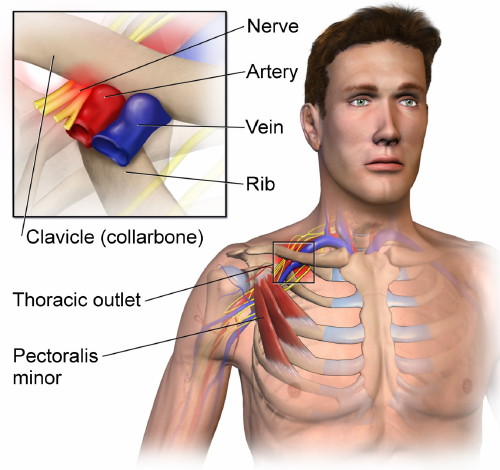How to Relieve Carpal Tunnel Syndrome with Clinical Somatics
If you have carpal tunnel syndrome, you might feel shooting pain, burning, tingling, numbness, and weakness in your hand and wrist. You may have developed carpal tunnel syndrome from doing repetitive tasks with your arms and hands, like computer work, massage therapy, playing a musical instrument, or working on an assembly line.
While you may not be able to avoid the activity that caused your carpal tunnel syndrome, you can relieve your symptoms by changing your habitual movement patterns that have put you in pain.
How Nerve Compression Causes Carpal Tunnel Syndrome
The brachial plexus is a bundle of nerves formed from the lower four cervical spinal nerves and first thoracic spinal nerve. The plexus travels from the spinal cord through the neck, through the thoracic outlet (see Illustration 1), and into the armpit.

Illustration 1: The Thoracic Outlet
The brachial plexus branches apart into nerves that provide sensation and muscular control to the chest, shoulder, arm, and hand. One of these nerves is the median nerve.
Your median nerve passes between the carpal bones and the transverse carpal ligament of your wrist (see Illustration 2). When this nerve is compressed, you experience the painful symptoms of carpal tunnel syndrome.

Illustration 2: The Median Nerve Passing Through the Carpal Tunnel
If you have carpal tunnel syndrome and do repetitive tasks with your hands, it’s very likely that your median nerve is being compressed as it passes through the carpal tunnel of your wrist. However, it’s important to remember that compression of this nerve can occur anywhere along its path: in your forearm, elbow, upper arm, thoracic outlet, and even where the nerves emerge from the spinal cord in between your vertebrae.
The most common cause of nerve compression is chronically tight muscles. For example, if you have tight muscles in your neck, these tight muscles can press your cervical vertebrae together, in turn compressing the nerves that pass through the spaces in between the vertebrae. So, nerve sensation that you experience in your wrist and hand can be the result of tight muscles in your neck—or chest, shoulder, arm, wrist, or hand.
How Our Habitual Movement Patterns Lead to Carpal Tunnel Syndrome
People who experience carpal tunnel syndrome typically have chronic muscle tension in their neck, shoulder, chest, waist, and back in addition to their arm, wrist, and hand. This muscle tension is the result of stress and habitual movement patterns that have caused muscle tension to gradually build up over time. As the muscles in the torso become tight and immobile, we’re forced to overuse our forearm, wrist, and hand to complete tasks.
The joints of our extremities, like the wrist joint, are designed to do less work than the joints closer to the center of our body. For example, in a reaching movement, most of the range of motion should come from a bending or twisting of our spine. Then our shoulder blade will slide to allow more movement, and lastly the joints of our arm and hand will articulate as needed in order to complete the task. When we have limited range of motion in the core of our body, we demand far more movement from our wrist than the joint is equipped to do, and irritation, inflammation, and pain occur as a result.
How to Relieve Carpal Tunnel Syndrome
While taking a break from the activity that caused your carpal tunnel syndrome can provide the most immediate relief, it’s not always possible, especially if it’s how you earn your living. Icing your wrist joint and wearing a wrist brace may help to reduce inflammation and overuse of the joint. But to make lasting progress in relieving your symptoms, you should learn to release the chronic muscle tension and retrain the habitual movement patterns that are causing your pain.
The following exercises from the Level One & Two Courses are the most effective exercises for releasing the tight muscles involved in most cases of carpal tunnel syndrome.
LEVEL ONE COURSE
Arch & Flatten: This exercise allows you to release and regain control of the lower back and abdominal muscles, improving the alignment of the pelvis and lower back.
Back Lift: This exercise is practiced lying on the stomach, allowing you to most effectively pandiculate the muscles on the back side of your body, including your shoulder and back muscles.
Arch & Curl: This exercise releases the abdominal, chest, and neck muscles.
Side Curl: This exercise releases the obliques and quadratus lumborum, which are often tight along with carpal tunnel syndrome, as they pull the spine to one side while doing repetive tasks.
One-Sided Arch & Curl and Diagonal Arch & Curl: Like the Arch & Curl, these exercises release the abdominal, chest, and neck muscles. They focus on one side of your body at a time, allowing you to address imbalances in your muscular patterns.
Bonus Carpal Tunnel Exercise Video: This series includes exercises that release the obliques, pectorals, arms, hands, and wrists.
Flowering Arch & Curl: This is a bigger, full-body version of the Arch & Curl. It has the added benefit of releasing internal rotation of the shoulders.
LEVEL TWO COURSE
Scapula Scoops 1 & 2: These exercises release the muscles that can keep the shoulder locked in place, including the upper and middle trapezius, rhomboids, and pectorals.
Shoulder Directions: This exercise releases and improves fine voluntary control of the muscles that move the shoulder.
Shoulders, Elbow, and Wrist Releases: These exercises release the muscles of the shoulder, arm, wrist, and hand.
Proprioceptive Exercises 1, 2, 3, and 4: These exercises allow you to retrain your posture, which can be misaligned in cases of carpal tunnel syndrome due to repetitive physical work.
Recommended reading:
The Pain Relief Secret: How to Retrain Your Nervous System, Heal Your Body, and Overcome Chronic Pain by Sarah Warren, CSE
Somatics: Reawakening the Mind’s Control of Movement, Flexibility and Health by Thomas Hanna

